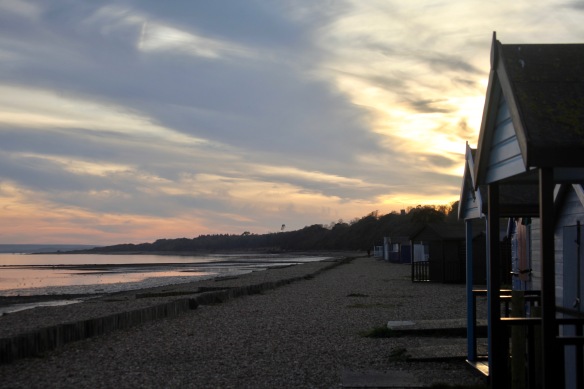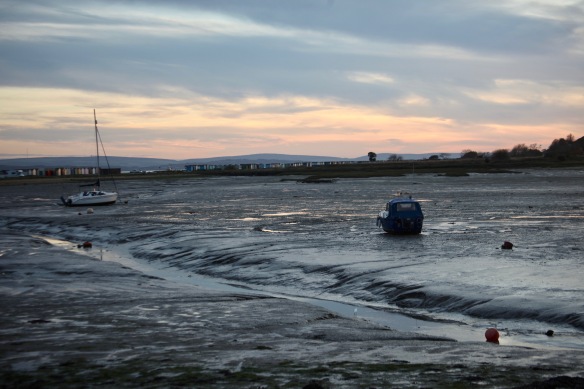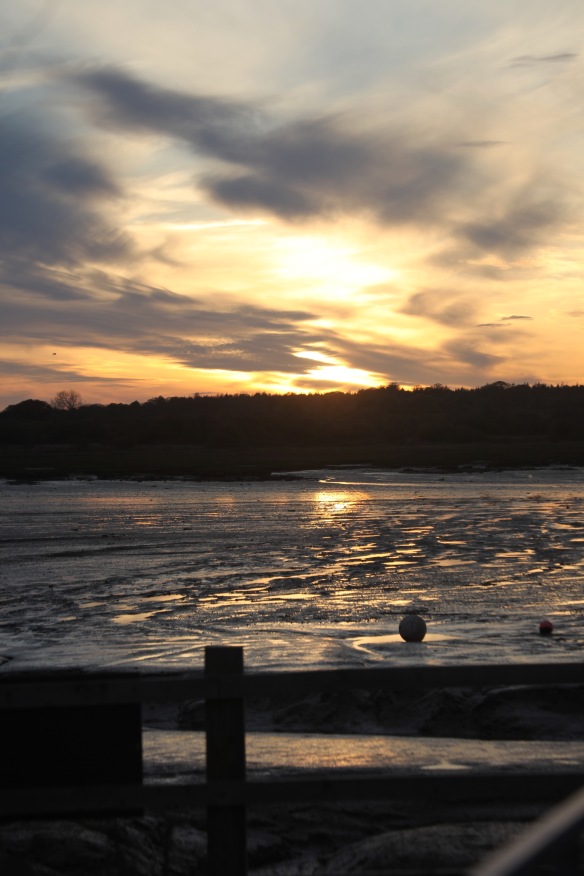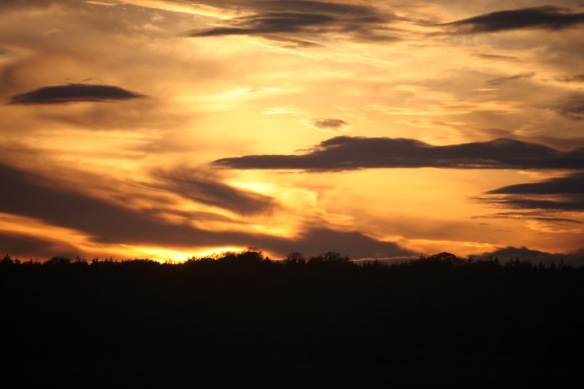CLICK ON IMAGES TO ENLARGE. REPEAT IF REQUIRED
This afternoon Jackie drove us to Calshot and back in order to watch the sun go down.
The tide was up in the Beaulieu River, offering reflections of Beaulieu Palace House
and of private houses.
Along Rollestone Road the ancient and modern meet in the forms of ponies grazing freely on historic moorland and the towers of Fawley Power Station.
We arrived at Calshot shortly before sunset. The tide had ebbed; buoys were beached,
and large vessels glided past,
towards the low sun that lit the beach huts’ verandas.
Swirling clouds splashed around the western sun
while, to the east, smooth water reflected its effects.
Parked boats were mirrored in pools on the quayside.
Shallow water glistened
and gleamed,
as did the windows of Houston House
which bears this plaque.
Wikipedia tells us that:
‘The Coupe d’Aviation Maritime Jacques Schneider, commonly called the Schneider Trophy or Schneider Prize (sometimes incorrectly referred to as the Schneider Cup, a different prize), was a trophy awarded annually (and later, biannually) to the winner of a race for seaplanes and flying boats. The Schneider Trophy is now held at the Science Museum, South Kensington, London.
Announced in 1912 by Jacques Schneider, a French financier, balloonist and aircraft enthusiast, the competition offered a prize of approximately £1,000. The race was held twelve times between 1913 and 1931. It was intended to encourage technical advances in civil aviation but became a contest for pure speed with laps over a (usually) triangular course (initially 280 km, later 350 km). The contests were staged as time trials, with aircraft setting off individually at pre-agreed times, usually 15 minutes apart. The contests were very popular and some attracted crowds of over 200,000 spectators. An earlier trophy, also presented by Jacques Schneider in 1910, in France, was the Schneider Cup, which is now in the possession of the RAF College Cranwell.’
and
‘In 1931 the British government withdrew support, but a private donation of £100,000 from Lucy, Lady Houston, allowed Supermarine to compete and win on 13 September against only British opposition, with reportedly half a million spectators lining the beachfronts. The Italian, French, and German entrants failed to ready their aircraft in time for the competition. The remaining British team set both a new world speed record (610 km/h (380 mph)) and won the trophy outright with a third straight win.[7] The following days saw the winning Supermarine S.6B further break the world speed record twice, making it the first craft to break the 400 mph barrier on 29 September at an average speed of 655.8 km/h (407.5 mph).’
As the sun gravitated towards
the horizon,
orange hues
spread
and deepened.
A jet trail pierced the indigo backcloth,
and the palette introduced red pigments
streaking
across the firmament;
finally dipping into the stream running alongside Jack Maynard Road.
This evening, for dinner, we enjoyed Jackie’s splendid beef and mushroom pie; boiled potatoes, carrots and cabbage, with which I drank more of the madiran.

























I think those photos are your best. The last one especially.
Many thanks, Alex
A lovely, reflective post, Derrick!
Many thanks, Brenda (especially reflective)
Loved your story about the Schneider Trophy, and the interesting history of the seaplane race, and the link with Houston House.
Many thanks, Ivor
You saved the best for last with these photos, Derrick, although there’s one with golden tones I like very much too. It reminds me of a Turner painting.
Very many thanks, Susanne. And Turner took much longer over his 🙂
Thanks for the great bit of aviation history.
Many thanks, Oglach
I’m always amazed by how quickly the sky changes. Great photos, Derrick!
It is amazing, Jill. I almost missed the reflection in the stream in the time it took to get out of the car and cross the road. Thanks very much
Terrific pictures, as always, but I particularly like the one of the boat reflected in the puddle.
Thanks a lot, Laurie. I rather liked that one myself
I’m sure your sunsets are more lovely than mine – though it may be because I am not out hunting for them with my camera at hand that I miss out…… The first two shots show another world and would make quite challenging jigsaw puzzles!
What a good idea for jigsaw puzzles, Pauline. I think these sunsets are down to the time of year. It is amazing how they suddenly burst into flame. Thanks a lot
Nice!!! Kisses <3 <3 <3
Many thanks, Nilda XXX
You tell an interesting story Derrick. Thank you.
Thanks very much, Roland
Another wonderful sunset series. 😀
Many thanks, Widders. There are so many good ones at this time
It can be hard to capture the beauty of the sky at sunset…you did it so well here, in so many beautiful shots. Excellent post, Derrick.
Very many thanks, Van
Glorious photos! This post should win an award!
Very many thanks, Luanne
Amazing sunset. Such lovely photos.
Many thanks, Arlene
I was not aware of the history of Schneider Trophy. Those are amazingly noiseless low light shots –the sea-facing verandas look clean. The clouds were certainly on fire, and so was your camera. Is this all at the base ISO?
It is all on automatic. Although back in the ’60s I knew about shutter speeds, apertures, manual focussing, and stuff, I got lazy as the years went by, and think, especially in this digital age, it is all too much to learn again. Many thanks, Uma
Sometimes, it’s not worth the pain.
Agreed 🙂
Not every cloud has a silver lining, because some are gold and some are red…
Many thanks, Bruce
Lovely photographic journey and loved the lilttle tidbit of history about the Houston house. 🙂
Thanks very much, Natalie
You’re welcome❣️😊
I think you meant to say ‘Calshot’ , Chalcot is up somewhere around Bath, It did say CALSHOT clearly on the plaque on the wall at Houston House! Love ya!
Oh! Sod it! Done it again! X
I think I should start referring to you as Mr. Robert Frost (the English version). 😉
Ha! Jackie just schooled you 😀
Thank you very much for this double-edged comment, Rose. I’m always doing that with that place. (Past London connections) 🙂
🙂
Now that’s what I call a sunset!
So many at the moment, John. Many thanks
Ah – the birth of the Spitfire and all that. RJ Mitchell’s designing genius. Wonderful shots too; what more could we ask? 🙂
Thanks very much, Mike
Stunning photos, Derrick. The final photo is like an Impressionist painting.
Very many thanks, Merril
Gorgeous captures
Thanks very much, Tosha
You’re welcome co
Such a wonderful sunset!
Many thanks, Helen
I am always entertained by you.
That’s lovely, Pamela. Many thanks
Dramatic sky, changing canvas of Mother Nature. You’ve captured them wonderfully… 🙂
Thanks very much, Maniparna
Ahh! Your sky shots are superb!
Thanks a lot, Rob
So beautiful!
Many thanks, Clare
Gorgeous!! The first photo is stunning!
Thanks very much Lynn
Great photographic account of a beautiful afternoon..
Thanks very much, Inese
Interesting history on the Schneider Trophy . I had not heard of it before. Always something new to learn here, Derrick!
The cloud photos are spectacular, especially the ones where clouds sailing at different levels can be seen, giving the feeling of depth in the sky. It really is an ocean of sorts. The colors change rapidly at the beginning and end of the day. Nature’s ephemeral jewels.
Many thanks, Lavinia. A lovely description of the clouds.
I had to go and read up on Lady Houston, am I glad I did.
What a mighty woman she was.In one sense we might almost say it was she that saved England / Great Britain through her involvement with the Supermarine aircraft, forerunners to the mighty Spitfire of Battle of Britain fame.
Thank you again Derrick, you area great teacher.You spike the interest and send us on the search for knowledge
Very many thanks, Brian. That is an interesting perspective on Lady H; and I appreciate the last paragraph, especially
Wow, loved these collection of photos Derrick, Loved the skies and the last photo reflection, That would make a great painting xx
Very many thanks, Sue
🙂 the pleasure was ALL mine.
Such beautiful photos. The first one is amazing. 👌🏾
Thank you very much, Persia
Interesting woman. Strange how our government had no interest in rearming. It’s the same with Lord Rothermere and the Bristol Blenheim. Lovely photos too.
Thanks very much, Quercus
Just shows how interesting blogging can be!